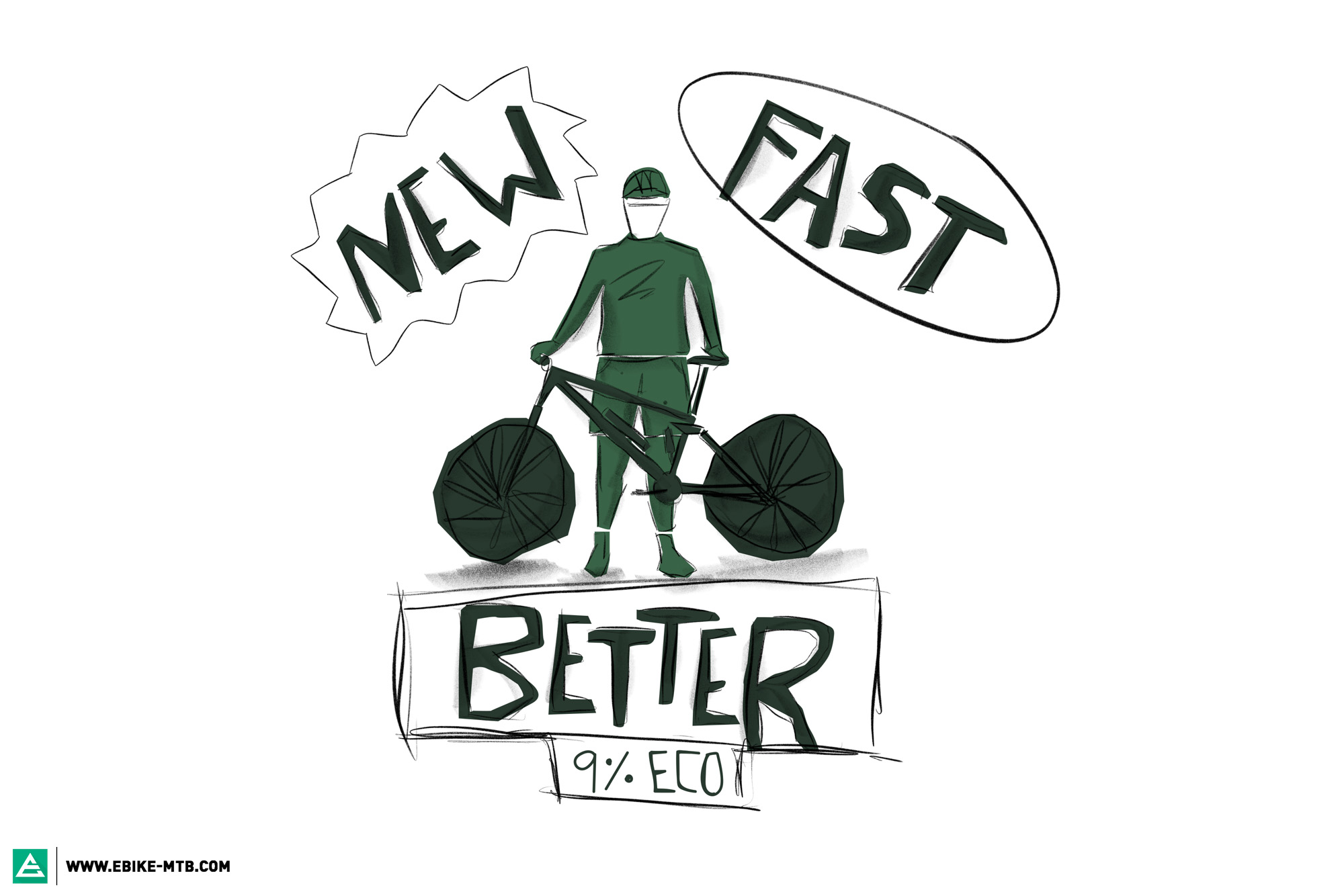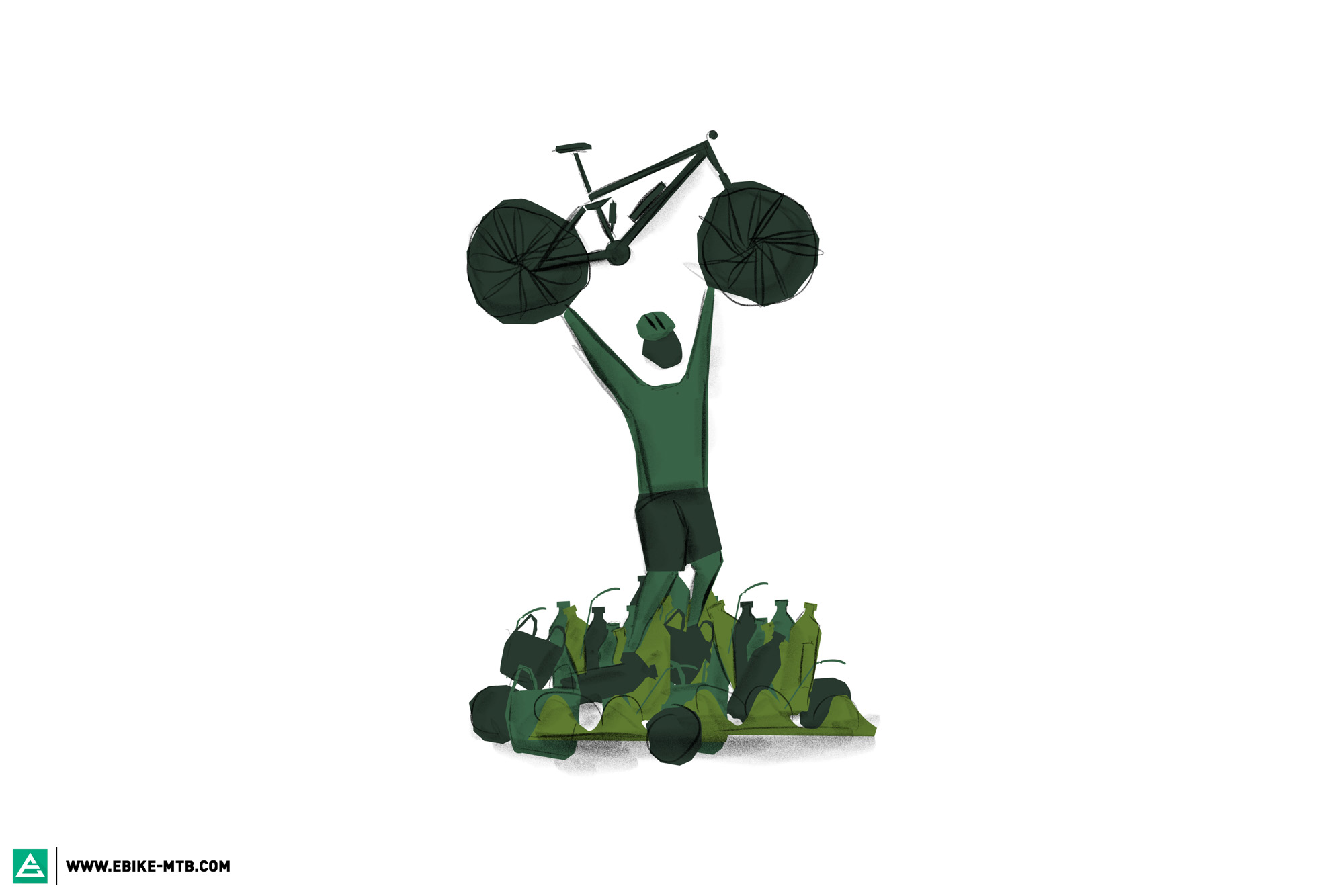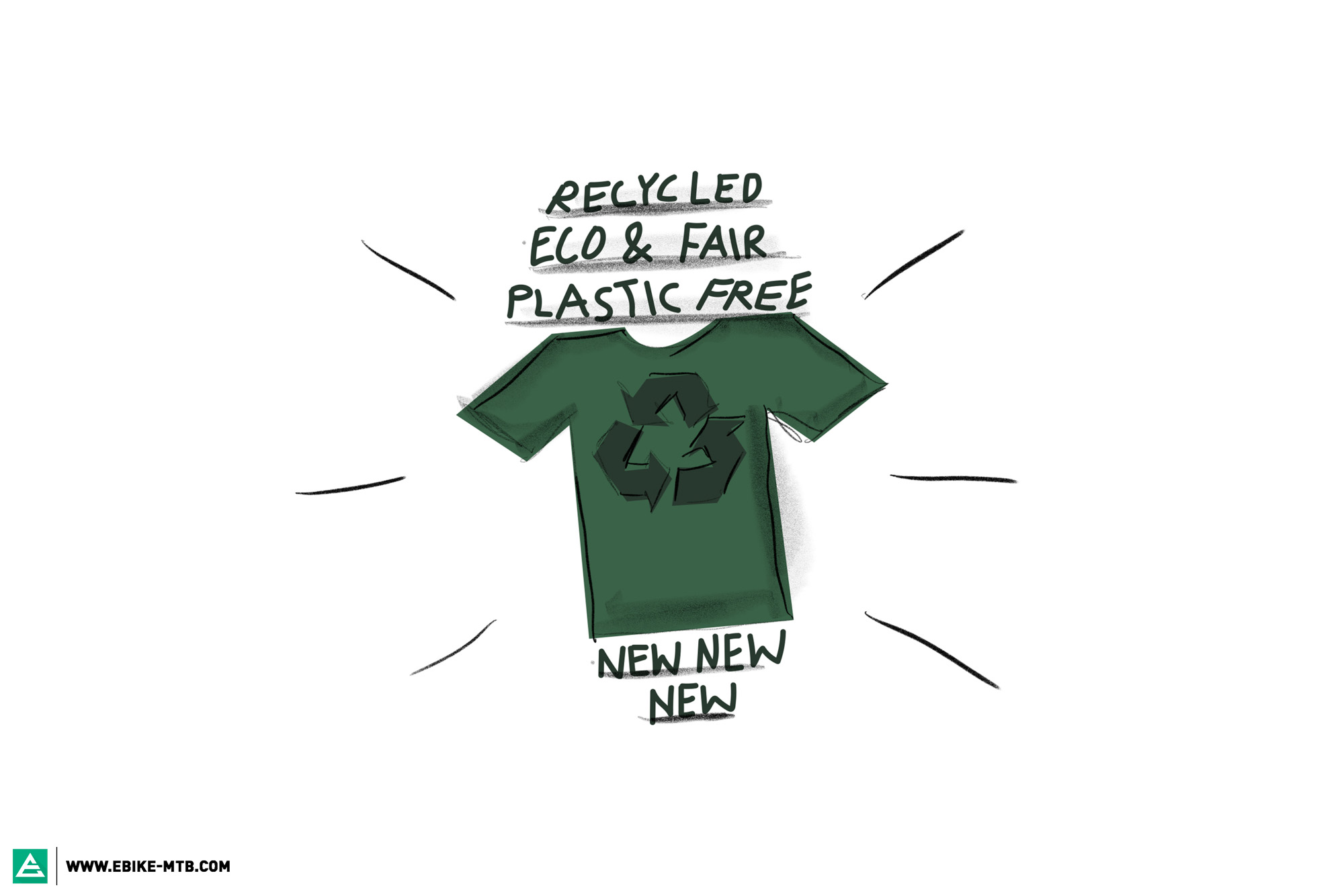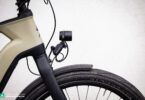The bike is the icon of emission-free mobility par excellence. But just how sustainable is our passion for bikes really? We took a fresh look at 6 aspects of cycling, including some new eco-friendly approaches, and reflected on the way we want to get around in the future.
Sustainability, oh jeez! Somehow we expect everything that is to come now to be both painful and uncomfortable, right? You would think that, as a cyclist, you automatically find yourself on the sunny side of the discourse: saving CO2, space and noise – the bike is a cornerstone of the green revolution. Yet you can already sense that in the wake of this positive image, a sometimes obscene battle for materials is raging over minimal performance advantages, differentiating features, and technological innovations. By the time the resource-intensively produced and expensively purchased marginal gains are transported around the globe to be ridden around in a chic new outfit, the gap between sustainable aspirations and consumerist reality becomes so wide that you almost need a new full-suspension eMTB to jump over it. Made out of carbon, of course. Ouch!

By the way, this realisation is not only painful for those reading this text, but also for the author. After all, we as a magazine also fuel the desire for novelty, and tend to define the innovative character of bikes, parts or clothes by their performance at the limit and not by their longevity or how easy they are to repair. Therefore, our aim is not to point the finger at anyone or to put it (the finger!) into already open wounds, but to create a new awareness and to shine a light on the areas where new ideas and impulses are being developed that can lead us out of this dilemma.

Over-engineering vs. ecological footprint
Cycling is THE winning card when it comes to the mobility of the future. A theoretically long lifespan is matched by reasonable CO2 emissions from production. The ecological balance depends mainly on the amount of time the bike is used. An intensively used carbon bike can therefore theoretically have a better ecological footprint than an alloy frame. With a carbon frame, there is also no alternative but to ride it as long as possible, and then throw it away. Unlike aluminium, carbon cannot be truly recycled. So the sustainability debate goes beyond the lifespan of a product – or is this where it really begins?
And what about ebikes? In theory, the ebike is also an ecological saviour, but this only marks a trend of many innovations in the bike industry. More torque and more range have led to oversized electronic behemoths whose potential is rarely exploited. The maxim seems to be “having is better than needing”. The big battery is bought out of range anxiety, not necessarily because we actually ride that far. And as a result, since we usually want more than we actually need, our ecological footprint keeps on growing!
The very parts that make repair difficult, limit durability and complicate disposal are – in combination with the electronics, many proprietary parts and the high complexity – the battery and motor, regardless of capacity or power. The new generation of minimalist, fully integrated light ebikes is no exception.
Perhaps the next innovation will no longer consist of better performance figures or unique system integration, but of a standardised charging port and reliable, repairable systems? Our most recent eMTB comparison tests show that the number of errors and fault reports for some motor manufacturers are skyrocketing, and in some instances technologies are installed that are simply not yet ready for the market. This is not only annoying for the customer, but also increases the need for maintenance.
We are thinking here of an aspect that, in terms of sustainability, is in many cases more relevant than the resources consumed in production or the power consumption in everyday life: the actual useful life of a product. As the saying goes, the most sustainable thing is always the one you already own. In this context, a lifecycle study comes to the following conclusion on the subject of ebikes:
“Especially the great dynamics of the market due to regular innovations, product renewals, and the lack of spare parts availability for older models make the long-term use by customers much more difficult compared to conventional bicycles.”

Useful life is the part of the equation that determines in real life whether a product is sustainable or not. For bikes, and especially for ebikes, this is less dependent on the robustness of the frame than on the components’ susceptibility to damage, or ability to be repaired and upgraded. More standardised parts with greater depth of development, a guaranteed supply of spare parts, and longer product life cycles may be part of the solution. However, a different approach to brand communication and product policy by the manufacturers, coupled with a fresh mindset among consumers, are just as much a part of the process. Rather than just innovating the product, we need to innovate the business model.
Because even if you theoretically could get your ebike repaired, unfortunately you can’t always get it fixed when you need it. It is not uncommon that bikers who struggle with a faulty motor take their online or second-hand purchased ebike to the local specialist workshop just to be told quite bluntly that “the chance of an appointment this spring looks rather bleak” and that they “can’t help with this brand anyway”. In addition, most ebike motor brands follow a rather prohibitive servicing scheme. By not offering certified repairs outside the official warranty period, customers are steered towards costly replacement motors. In the end it is not enough to sell many (expensive) bikes, we also need brands that provide a sustainable servicing model and workshops to carry it out. The business model of offering a complex ebike online and not thinking about service and repair is fundamentally unsustainable, and more akin to a throwaway mentality.
The Dutch brand VanMoof also came to this conclusion. As the “Tesla of the bike world”, they wanted to achieve great things, but reached their limits due to the many proprietary parts and the lack of existing service infrastructure. After all, no matter how fancy or expensive your urban ebike, it can’t replace any car journeys if it is gathering dust in the basement with an irreparable fault.
High-end vs. high-quality
However, the trend towards increasingly high-performance bikes, innovative components and rising maintenance requirements is by no means specific to ebikes. It fundamentally intensifies the further we move away from the general idea of the bike as a “means of transport”, and it paradoxically leads to a reduction in the durability and lifespan of high-end components. Super-slim 12-speed chains face rapidly wearing 10-tooth sprockets, ultra-powerful brake pads often have to be changed after just 1,000 km (or 1,000 vertical metres downhill on the MTB), and complete cranksets are replaced – along with the expensive power meter – when a chainring is worn out.
For the racing world, former road pro David Millar describes the paradox as follows: “A lot of the pro racing stuff is almost disposable.” In other words, the most expensive parts may offer maximum performance in the short term, but they don’t last long. What could still be tolerated in terms of resources for a few thousand professional athletes worldwide, is a problem when the parts become a status symbol for the broad masses of bike aficionados, and quite often become a source of frustration.
Today, an unsurpassed amount of resources are used to produce parts that have an unsurpassed high performance but also an unsurpassed low durability. The solution is to broaden the concept of performance to include longevity, or simply put: a return to quality as the norm. No customer would perceive a washing machine as a premium product if it washes the laundry particularly clean, but ends up irreparably in washing machine heaven after a year.

Tour de France vs. Tour de Home
The pros put out more than 6 watts per kilo on Tour climbs, and the spectators dump more than 43 cubic metres of litter per 150 km of route into the landscape. For every bike that starts, there are 12 support, organisation or promotional vehicles, culminating in CO2 emissions equivalent to the annual output of a small town. The Tour de France is a mega sports event, yet it once began as what we would now call a “self-supported gravel race”.
Whether it’s the Tour de France, MTB World Cups or gravel adventures, races fascinate us – and rightly so. We let ourselves be carried away, spurred on to achieve our personal best, and share what we love with others. But sometimes great events become simple trophies in the Strava showcase. We are taking part so that we can cross them off our bucket list of ambitions and work our way up the power rankings within our circle of friends. Ötztaler Marathon in under 9 hours? Rad!!!
But most of these iconic events are accompanied by a crazy-long journey. Whether by car to the Alpine Marathon, or even by plane to the Cape Epic in South Africa: before we produce lactate, we produce CO2. But an adventure on a racing bike doesn’t require an Alpine pass, and an Everesting challenge on your local hill also serves as a status symbol, training goal or season highlight.
Besides Everesting, Corona has created plenty of other extremely tough cycling challenges. Whether it’s Everesting, or the infamous British HillClimb Championship, what matters is that the adventure starts on your doorstep. Besides, you can usually find local races everywhere, all organised with a lot of heart and soul by local clubs, and generally with a buffet of homemade food that you could only dream of at a big event.
And thinking one step further: Do you always need a challenge defined by others to challenge yourself? What about setting your personal goals, either on your own or with friends? It’s not about spoiling anyone’s dream of the Ötztaler, but about adding a new, unique dimension to what excites us about cycling.

Good intentions vs. bad consequences
“Don’t buy this jacket”, cheekily read an ad by Patagonia in 2012. Underneath it, a fleece jacket. The message behind it: Question your consumption behaviour, make conscious decisions, and consume less. The jacket sold out immediately.
It seems that nothing motivates us to consume more than the prospect of making the world a better place. Patagonia founder Yvon Chouinard stated that every time he made a good decision for the planet, he ended up making a good deal for himself. To assess whether the decision to call for nonconsumption – even if it increases consumption – is really good for the planet is beyond the scope of this short article. But the campaign has cemented Patagonia’s image as a responsible and sustainable company.
We like to rally behind eco-labels, refer to manufacturers’ recycling promises and quickly throw the word “ocean plastic” into the mix before clicking “buy”. The question is, does that really make anything better? Or does it just give us a comfy feeling that we don’t really want to question?
Cool style vs. good material
Recycling is the magic word that turns bad plastic into seemingly good plastic. And our goal of dispensing with new PET is obviously right, because as limited as the resources are that we need to produce plastic, the material itself is unfortunately infinite. Plastic does not disappear, it merely disintegrates into microscopic pieces. This microplastic gets into the water, the food and finally into our bodies.
These concerns are also reflected in the new strategies of the apparel brands. Adidas, for example, are committed to eliminating the use of virgin plastics by 2024 and have also developed functional fibres that will release fewer microfibres into the environment. Most brands now have a product line or a complete collection made from recycled PET, and are also striving to make packaging and shipping plastic-free.
However, recycling alone does not solve the microplastic problem. Clothes made from recycled plastic tend to release even more microfibres into the water when washed than textiles made from new PET, as the old, pre-worn fibres wash out more quickly.
But what are the alternatives? Merino wool, a material that has long dominated cycling, has experienced a revival in recent years. It still keeps you warm when it gets wet, cools you down in the heat and doesn’t stink (quite as much).
Another focus is on bio-based and biodegradable plastics. The former are produced from biomass, the latter decompose without residues under certain conditions. In the functional clothing sector, the miracle fabrics are now making their way into the first collections. Vaude, for example, uses castor oil-based bio-plastics to save on conventional plastic, and Kathmandu has developed a biodegradable down jacket. “Green plastic” is a hot topic in the textile industry and has the potential to shape a new generation of products. This includes the Zen Running Club’s running shoes, which are made from three main plant-based ingredients: sugar cane, eucalyptus and natural rubber. However, it is not yet possible to rely entirely on plant-based ingredients, and the global supply chain is also still a challenge. Even if you want to make the right decisions, it still takes time before “better” really becomes “good”. Until then, the crucial point in textile sustainability remains your own behaviour.

Wanting vs. needing
Much of what we want, we don’t need. Manufacturers such as Patagonia or Velocio are trying to show their customers that conscious purchasing and thus also nonconsumption are the path to consumer happiness. Others rely on second-hand platforms (yes, for cycling gear), present their thoughts on the topic of sustainability in documentary formats, or make their customers “pre-order” before the start of production of the new collection so that they don’t have to sell off or throw away any goods afterwards. How much of that is marketing, you ask? Probably quite a bit.
But perhaps that doesn’t really matter in the end. Owning something for a long time, caring for it, washing it properly – which means washing it less – repairing it and really appreciating it can be very satisfying. If it becomes a trend to treat your bike and equipment like this, then it certainly promises more pleasure in the long run than the brief rush of victory from a successful bargain hunt.
Everything we do has consequences – for us, for others, and for the environment; we all have to find the balance between pleasure and consequences for ourselves. And every now and then you have to renegotiate with yourself what the “right” balance is, and that often means having to live with contradictions. It would be a shame not to do something right, just because you can’t or don’t want to do everything right. That said, what we can do is to value more what we already have, not chase after every marketing promise, and always stay open and alert for new ideas and solutions.
Did you enjoy this article? If so, we would be stoked if you decide to support us with a monthly contribution. By becoming a supporter of E-MOUNTAINBIKE, you will help secure a sustainable future for high-quality cycling journalism. Click here to learn more.
Words: Nils Hofmeister Photos: Julian Lemme









